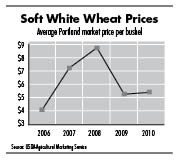
Home » Ag could have another strong year
Ag could have another strong year

December 16, 2010
A drought a continent away and an ideal growing season here last spring contributed to continued strong wheat prices for Inland Northwest farmers in 2010 and a likelihood that 2011 could be strong as well. Other regional crops also had above-average yields and market conditions this year, and observers are optimistic about next year's harvests.
"We had a pretty decent wheat crop, and depending on the marketing of the producers, there was a bump up in price at the end of the harvest, which was mostly caused by the drought in Russia," says Jay Penick, president and CEO of Spokane-based ag lender Northwest Farm Credit Services. "As a result, most of the wheat producers will have a pretty decent year, and as we look at 2011, we have an opportunity to lock in pretty nice prices."
Costs, including for seed and fertilizer, however, are expected to rise next year, and other hurdles remain, Penick says.
"The biggest challenge we got into was the wet weather late this fall," which could have prevented growers from getting their winter wheat seed in the ground before the first snowfall, he says.
Tom Mick, president of the Washington Grain Commission, says that when the first snow fell last month, it helped to insulate the ground from the deep freeze that followed. "Hopefully most of that (grain) will come through the winter in pretty good shape," Mick says.
He adds that although there is an adequate global supply of wheat right now, the drought in Russia and Eastern Europe caused a panic, which kept prices high after the end of harvest.
"This could equate to next year's market, which starts June 1, being in a very strong position," he says, but cautions that, "Anything can happen in the grain industry."
Meanwhile, although 2010 began with depressed potato prices, Penick believes that both 2010 and 2011 will be above-average years for that crop.
One sector of the ag market that struggled this year, and might continue to feel negative impacts in 2011, is the dairy industry, Penick says.
"Early 2010 was pretty tough because they had depressed prices and high costs," he says. "In the second half of the year, most producers were able to make a little money because prices for milk came up significantly. But, as we look at the first half of 2011, I think it will be a difficult time."
Penick says higher grain prices might drive up feed costs further for dairy farmers, and even a boost in milk prices might not be enough to offset that hit.
In the Palouse, growers of dry peas, lentils, and chickpeas all enjoyed an above average year for crop quality and market prices in 2010, says Todd Scholz of the Moscow, Idaho-based U.S.A. Dry Pea & Lentil Council.
Scholz says that next year, such legumes will have to compete with wheat on the Palouse for planting acreage, because of wheat's high prices. Yet, he says the 2011 outlook for lentils remains positive, suggesting that farmers still will be motivated to plant them next season.
He says that chickpeas, the main ingredient in the popular spread hummus, also likely will have as strong a market as this year.
Two countries to watch, says Scholz, are Canada and Australia, two big competitors for the Palouse's dry peas and lentils. "Canada had a hard time with their crop, and Australia had some wet weather which could impact prices here positively," he says. "So those are hopeful signs."
—Chey Scott
Latest News
Related Articles




_web.jpg?1729753270)